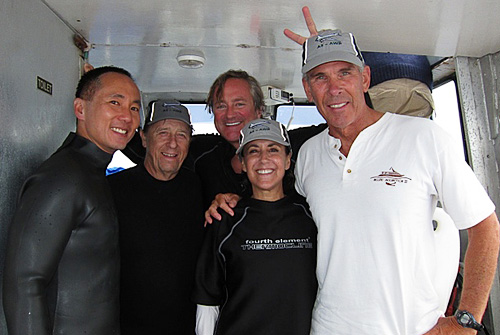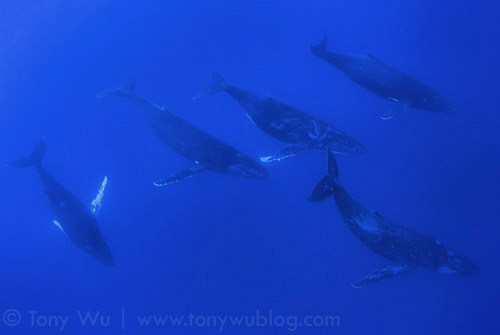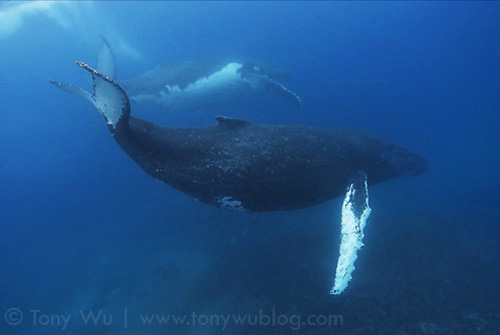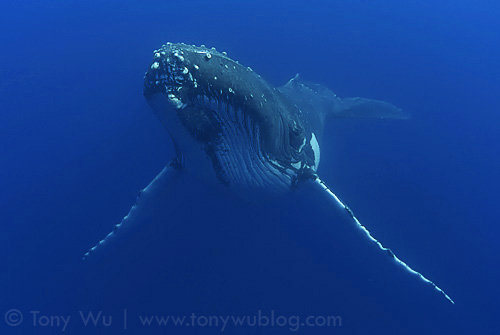My first update from Tonga for this season is going to be short. I’ve only gone out on the water for one day, but it was an eventful one.
I arrived at Mounu Island Resort on 16 August, settled in, set up and tested my gear on the 17th, and went out to sea yesterday with my friends Douglas Seifert, Howard and Michele Hall, and Jerry Allen.

Me with Jerry, Douglas, Michele and Howard
The weather was so-so, mostly overcast with drizzles every now and then, but we were fortunate enough to come across a group of five humpback whales within short order. They weren’t in any particular hurry, but the whales also weren’t overly friendly, so we only saw them a few times underwater.
The whales passed mostly at depth, but I managed to get all five in a single frame...not bad for one of the first photos I’ve taken with my new Canon 5D Mark III camera and Zillion housing.

Five humpback whales traveling together
Of particular note, there seems to be an abundance of whales with all-white pectoral fins this season (like the left-most whale in the above photo). The last time I recall seeing a large number of humpback whales with this trait visiting Vava’u was in 2006. In most seasons, I’ve seen very few, if any at all.
Most people probably wouldn’t get excited by something like this, but I’ve been tracking unique physical traits among the humpback whales that visit this part of Tonga for some time now, and the reappearance of a significant number of whales with white pectoral fins could be important.
In many seasons, there seems to be some obvious physical trait that a critical number of whales share. White pectoral fins is one example. All-black bodies, as well as split dorsal fins, are two more I’ve been on the lookout for.
I have a hunch that these shared outward physical traits are signs of genetic proximity. In other words, if a number of whales share a common physical trait, they might be relatively closely related...and they may coordinate their movements to some degree.
It’s tough to prove this without collecting DNA, but the fact that certain traits appear in greater-than-average quantities in certain years (but not in most years) is certainly suggestive of some sort of link.
I’ve rambled about this in updates in previous years, so on the off chance you’re interested in reading more, take a look in my blog archives for posts during August and September from past seasons.
So far this season, Ma’ata, who works at Mounu Island Resort, has photographed two mother/ calf pairs with all-white pectoral fins. The one in the photo above makes five individuals with this trait. And as if to hammer the point home, the next whale I photographed a few hours later was also one with white pectoral fins.

This is the sixth humpback whale with white pectoral fins this season.
So that makes six whales with all-white pectoral fins this season, and we’re just getting started! It’ll be interesting to see if we come across more as time goes on. In fact, it’ll be interesting even if we don’t see any more.
Speaking of mother/ calf pairs, Ma’ata has been photographing calves to contribute to my annual mother/ calf count, and we went through her photos this morning. So far, I can ID eight mother/ calf pairs from her photos...which is totally awesome.
By this time last year, we had 11 calves identified, so we’re not far behind. And I haven’t even spent any appreciable time in the water yet!
This season, I arrived in Tonga a couple weeks later than I normally do (I was in Alaska playing with northern humpbacks), so I was worried about falling behind in the count. Thanks to Ma’ata’s efforts though, the calf count is on schedule.
Request for help...If you are visiting Tonga this season, and you photograph any mother/ calf pairs, please save the photos for me, and please make a note of the date and location. I will compile all the data I receive into a file and publish the file for everyone to share, as I’ve done in previous years. Photos that are of most use are ones that clearly show physical traits of the mother and/ or calf...side-on views of the adult to see the body patterns; photos that show the shape of the dorsal fins; clear shots of flukes; photos of the underside of calves...to help determine the sex of each calf.
Our count for the 2011 humpback whale season in Vava’u was 48 humpback whale mother/ calf pairs...a record number that blew away all expectations! (and also made for a heckuva lot of work after I got home).
To wrap up, here is a photo of the whale that was accompanying the one with the white pectoral fins above. The pair were nice enough to slow down and stop for a break, giving us an opportunity to spend some quality time with them.

Resting humpback whale
My friend Jon Cornforth will be arriving tomorrow, for the continuation of our Megaptera Mania! dual-hemisphere humpback whale trip. The weather forecast looks good, so I can’t wait to take my friends out to look for more whales.